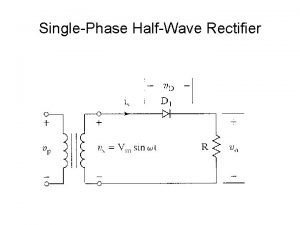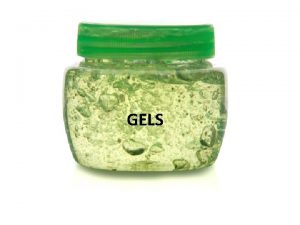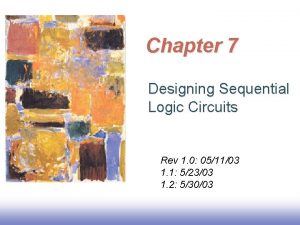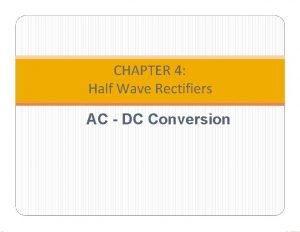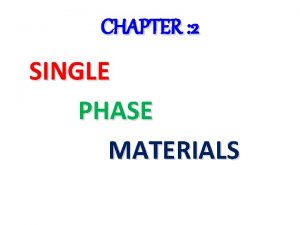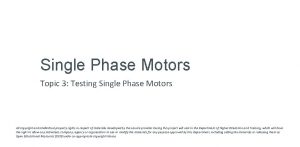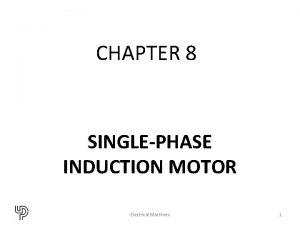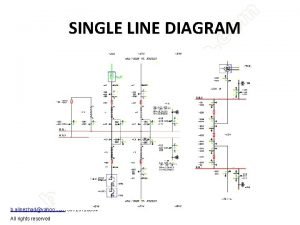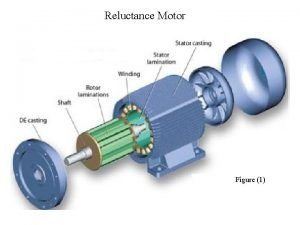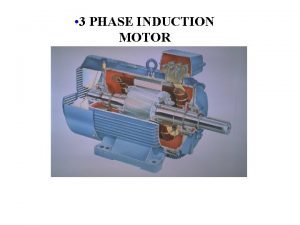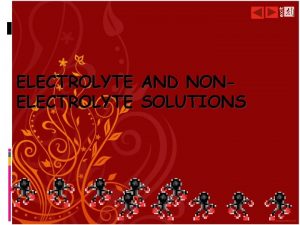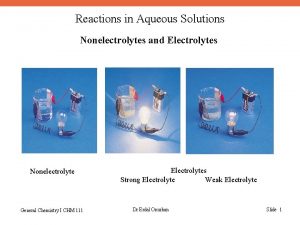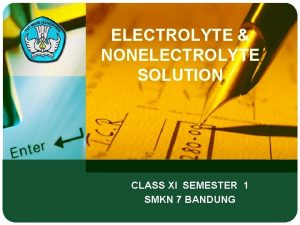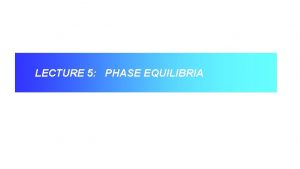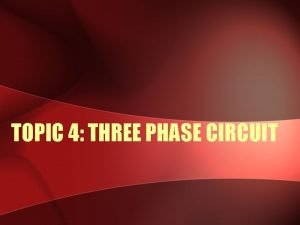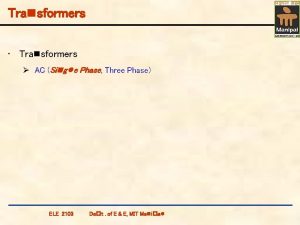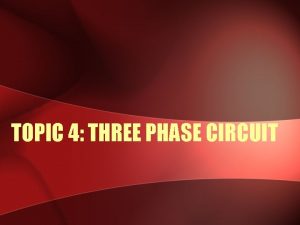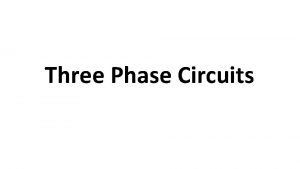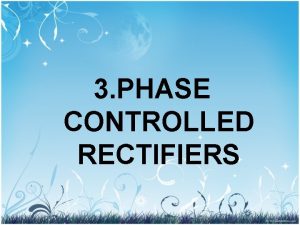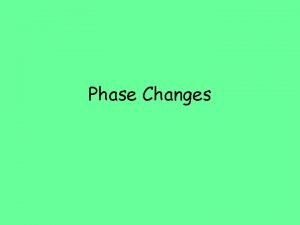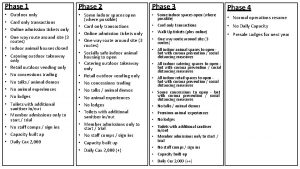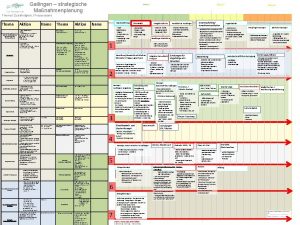Lecture 6 NONELECTROLYTE SOLUTONS NONELECTROLYTE SOLUTIONS single phase

















































- Slides: 49

Lecture 6. NONELECTROLYTE SOLUTONS

NONELECTROLYTE SOLUTIONS – single phase homogeneous mixture of two or more components NONELECTROLYTES – do not contain ionic species.

CONCENTRATION UNITS

CONCENTRATION UNITS

PARTIAL MOLAR VOLUME Imagine a huge volume of pure water at 25 °C. If we add 1 mol H 2 O, the volume increases 18 cm 3 (or 18 m. L). So, 18 cm 3 mol-1 is the molar volume of pure water.

PARTIAL MOLAR VOLUME • Now imagine a huge volume of pure ethanol and add 1 mol of pure H 2 O it. How much does the total volume increase by?

PARTIAL MOLAR VOLUME • When 1 mol H 2 O is added to a large volume of pure ethanol, the total volume only increases by ~ 14 cm 3. • The packing of water in pure water ethanol (i. e. the result of H-bonding interactions), results in only an increase of 14 cm 3.

PARTIAL MOLAR VOLUME • The quantity 14 cm 3 mol-1 is the partial molar volume of water in pure ethanol. • The partial molar volumes of the components of a mixture varies with composition as the molecular interactions varies as the composition changes from pure A to pure B.



PARTIAL MOLAR VOLUME n When a mixture is changed by dn. A of A and dn. B of B, then the total volume changes by:

PARTIAL MOLAR VOLUME

PARTIAL MOLAR VOLUME • How to measure partial molar volumes? • Measure dependence of the volume on composition. • Fit a function to data and determine the slope by differentiation.


PARTIAL MOLAR VOLUME • Molar volumes are always positive, but partial molar quantities need not be. The limiting partial molar volume of Mg. SO 4 in water is -1. 4 cm 3 mol-1, which means that the addition of 1 mol of Mg. SO 4 to a large volume of water results in a decrease in volume of 1. 4 cm 3.

PARTIAL MOLAR GIBBS ENERGIES • The concept of partial molar quantities can be extended to any extensive state function. • For a substance in a mixture, the chemical potential, m is defined as the partial molar Gibbs energy.


PARTIAL MOLAR GIBBS ENERGIES • Using the same arguments for the derivation of partial molar volumes, • Assumption: Constant pressure and temperature

THERMODYNAMICS OF MIXING • So we’ve seen how Gibbs energy of a mixture depends on composition. • We know at constant temperature and pressure systems tend towards lower Gibbs energy. • When we combine two ideal gases they mix spontaneously, so it must correspond to a decrease in G.

THERMODYNAMICS OF MIXING

DALTON’S LAW • The total pressure is the sum of all the partial pressure.

THERMODYNAMICS OF MIXING

Thermodynamics of mixing

Thermodynamics of mixing

THERMODYNAMICS OF MIXING

SAMPLE PROBLEM: • A container is divided into two equal compartments. One contains 3. 0 mol H 2(g) at 25 °C; the other contains 1. 0 mol N 2(g) at 25 °C. Calculate the Gibbs energy of mixing when the partition is removed.

Gibbs energy of mixing p p

ENTHALPY, ENTROPY OF MIXING


Other mixing functions

IDEAL SOLUTIONS • To discuss the equilibrium properties of liquid mixtures we need to know how the Gibbs energy of a liquid varies with composition. • We use the fact that, at equilibrium, the chemical potential of a substance present as a vapor must be equal to its chemical potential in the liquid.

IDEAL SOLUTIONS • Chemical potential of vapor equals the chemical potential of the liquid at equilibrium. n If another substance is added to the pure liquid, the chemical potential of A will change.

Ideal Solutions

RAOULT’S LAW The vapor pressure of a component of a solution is equal to the product of its mole fraction and the vapor pressure of the pure liquid.

SAMPLE PROBLEM: Liquids A and B form an ideal solution. At 45 o. C, the vapor pressure of pure A and pure B are 66 torr and 88 torr, respectively. Calculate the composition of the vapor in equilibrium with a solution containing 36 mole percent A at this temperature.

IDEAL SOLUTIONS:

Non-Ideal Solutions

Ideal-dilute solutions • Even if there are strong deviations from ideal behaviour, Raoult’s law is obeyed increasingly closely for the component in excess as it approaches purity.

Henry’s law • For real solutions at low concentrations, although the vapor pressure of the solute is proportional to its mole fraction, the constant of proportionality is not the vapor pressure of the pure substance.

Henry’s Law • Even if there are strong deviations from ideal behaviour, Raoult’s law is obeyed increasingly closely for the component in excess as it approaches purity.

Ideal-dilute solutions • Mixtures for which the solute obeys Henry’s Law and the solvent obeys Raoult’s Law are called ideal-dilute solutions.

Properties of Solutions • We’ve looked at thermodynamics of mixing ideal gases, and properties of ideal and ideal-dilute solutions, now we shall consider mixing ideal solutions, and more importantly the deviations from ideal behavior.

Ideal Solutions

Ideal Solutions

Ideal Solutions

Real Solutions • Real solutions are composed of particles for which A-A, A-B and B-B interactions are all different. • There may be enthalpy and volume changes when liquids mix. • DG=DH-TDS • So if DH is large and positive or DS is negative, then DG may be positive and the liquids may be immiscible.

Excess Functions • Thermodynamic properties of real solutions are expressed in terms of excess functions, XE. • An excess function is the difference between the observed thermodynamic function of mixing and the function for an ideal solution.

Real Solutions

Real Solutions Benzene/cyclohexane Tetrachloroethene/cyclopentan e
 Waiting line management system
Waiting line management system 01:640:244 lecture notes - lecture 15: plat, idah, farad
01:640:244 lecture notes - lecture 15: plat, idah, farad Normal phase vs reverse phase chromatography
Normal phase vs reverse phase chromatography Hplc reverse phase vs normal phase
Hplc reverse phase vs normal phase Mobile phase and stationary phase
Mobile phase and stationary phase Chromatography means
Chromatography means Normal phase vs reverse phase chromatography
Normal phase vs reverse phase chromatography Difference between phase voltage and line voltage
Difference between phase voltage and line voltage Which detector used in hplc
Which detector used in hplc In a ∆-connected source feeding a y-connected load
In a ∆-connected source feeding a y-connected load Broad phase vs narrow phase
Broad phase vs narrow phase Performance parameters of half wave rectifier
Performance parameters of half wave rectifier Semi converter operates in which quadrant
Semi converter operates in which quadrant Glycerogelatins
Glycerogelatins Single phase dual converter
Single phase dual converter Which flip-flop is insensitive to clock overlap?
Which flip-flop is insensitive to clock overlap? Rl load example
Rl load example Single phase alloy
Single phase alloy Ac voltage control using scr
Ac voltage control using scr Testing single phase motor
Testing single phase motor Single phase induction motor
Single phase induction motor Single line diagram 3 phase
Single line diagram 3 phase Reluctance motor
Reluctance motor Wound rotor
Wound rotor Sisd processor
Sisd processor Single instruction single data
Single instruction single data Project procurement management lecture notes
Project procurement management lecture notes Lecture about sport
Lecture about sport Lecture on healthy lifestyle
Lecture on healthy lifestyle Makeup lecture meaning
Makeup lecture meaning Meaning of this
Meaning of this Randy pausch last lecture summary
Randy pausch last lecture summary Tensorflow lecture
Tensorflow lecture Theology proper lecture notes
Theology proper lecture notes Strategic management lecture
Strategic management lecture Geology lecture series
Geology lecture series Social psychology lecture
Social psychology lecture In text citation for a lecture
In text citation for a lecture Public sector accounting lecture notes in uganda
Public sector accounting lecture notes in uganda Project management lecture notes doc
Project management lecture notes doc Eurocode lap lengths
Eurocode lap lengths Magnetism
Magnetism Classical mechanics
Classical mechanics Physics 101 lecture notes pdf
Physics 101 lecture notes pdf Physical science lecture notes
Physical science lecture notes Power system dynamics and stability lecture notes
Power system dynamics and stability lecture notes Natural language processing
Natural language processing Microbial physiology lecture notes
Microbial physiology lecture notes Introduction to mechatronics ppt
Introduction to mechatronics ppt Limits fits and tolerances
Limits fits and tolerances











